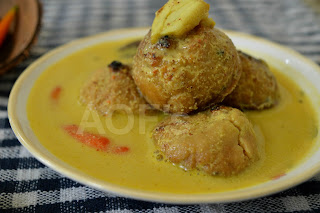Cooking Time Required: 15-20 mins
Ingredients:
- 1 no Kadali Bhanda/ banana flowers bunch
- 1 small potato
- 1 small tomato ( optional )
- 5-6 garlic flakes
- 2 tsp mustard seeds
- 2 green chilli
- 1 dry red chili
- 1 tsp mustard oil
- 1/5 tsp turmeric
- 2 tsp vegetable oil
- salt to taste
Preparation: Preparing the banana flowers is a time consuming and messy affair. It might just seem to be a daunting task for first timers.
Here is the list of steps that one needs to follow :
1. Rub a little bit of oil on your palms and fingers. This is to prevent blackening caused due to the sticky juice of the flowers.
2. Keep a bowl of water with salt and turmeric at hand.
3. Remove the outer hard dark pink/crimson-colored bracts. These are not edible.

4. Now remove the bunch of yellowish pink flowers just under the hard layers. Remove the thin long stamen (with a thick head) and a hard petal-like layer (tepal) from each flower. These two parts are not edible.

5. Cut up the flower into small pieces and immediately dunk it into the turmeric water. This prevents the flowers from darkening due to oxidation.
6. Repeat the process for each layer. After the first 5-6 layers, the flowers will be closed. Hold each bunch in one hand and rub your palm over the top part to open up the flowers. Now it will be easier to remove the stamen and the tepal.
7. The flowers will keep getting smaller in size. Once it reaches a length of 1.5 inch, one need not remove any of the parts. These can be chopped and added to turmeric water.
8. Boil the flowers along with the salt and turmeric water for about 3-4 mins. Drain and wash under running water to get rid of the bitterness. ( It is preferable to taste the flowers at this stage. If it still tastes too bitter for one's palate, it should be discarded ).
Cooking: Heat 3 tsp oil in a wok. Drain and squeeze the banana flowers and add to the wok. Stir fry for 5 mins. Remove from wok and transfer to a pressure cooker.
Cut the rest of the vegetables into small pieces and add to the pressure cooker.
Grind the dry red chili, mustard seeds, and half of the garlic flakes into a smooth paste. Add to the pressure cooker along with 1/4 cup of water.
Add the green chilies ( slit into 2 ), remaining garlic flakes, mustard oil, salt, and a pinch of turmeric.
Mix the contents of the pressure cooker and close the lid. Put on stove and allow to cook for 2 whistles.
Allow the steam to escape. Open the lid and check if there for excess water remaining. If so, put it back on the stove and cook on a high flame with the lid open to evaporate the water.
Serve with rice.
Note: This curry tastes best when cold and it is even better the next day. Most of the curries prepared with mustard and garlic taste best when served cold.
































